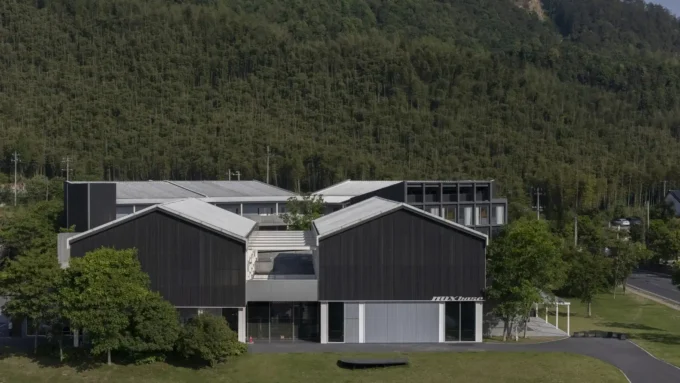Nestled near the historic Xing Kiln Ruins—one of China’s most significant ceramic heritage sites—Hermit Resort by Domain Architects is a poetic architectural response to the passage of time. The ruins, over 1,500 years old, once featured a cluster of kiln chambers arranged in a horseshoe formation around a small courtyard. This spatial organization allowed artisans to monitor multiple chambers at once, creating a functional yet symbolic bond between human craft and the land. Drawing from this ancient typology, the architects reinterpret the spirit of the ruins to craft a new kind of hospitality space—one that feels timeless, tactile, and deeply rooted in the terrain.

Reimagining the Concept of “Ruins”
The project site itself bears traces of history—remnants of a former village that was relocated, leaving behind fragmented stone walls and terraces on a gentle slope beside a stream. Instead of erasing these fragments, Domain Architects used them as the foundation for a new architectural relic. The design poses a provocative question: must contemporary architecture always strive for perfection and precision? Or can it instead embrace the rawness, ambiguity, and quiet beauty found in decay?
In Hermit Resort, the architects sought to capture the essence of archaeological ruins—the interplay of order and randomness. The overall layout maintains clarity and coherence, while the individual architectural elements appear weathered and irregular, giving the settlement a natural, time-worn authenticity. This delicate balance between control and spontaneity creates a settlement that feels both ancient and alive.

A Settlement of Fragmented Wholeness
The resort is composed of a cluster of small, single-story buildings scattered across the landscape like the remains of an ancient village. The arrangement evokes the organic composition of mountain settlements, where built forms, courtyards, and pathways interweave fluidly. Much like the Xing Kiln ruins, boundaries between beams, walls, and alleys dissolve into one another, producing a spatial experience that is at once intimate and labyrinthine.
This “microscopic randomness within macroscopic order” defines the resort’s character. From afar, the ensemble reads as a coherent landscape intervention; up close, it reveals an intricate network of courtyards, corridors, and semi-enclosed rooms that shift with light and shadow. The experience changes constantly—under bright sunlight, the forms appear crisp and sculptural; under cloud or moonlight, they dissolve into soft silhouettes that merge with the terrain.

Spatial Experience and Interior Atmosphere
Each of the 50 guest rooms is conceived as a self-contained microcosm with its own private courtyard. The spatial logic reverses conventional hospitality layouts: rather than treating the courtyard as an appendage to the room, the architecture wraps around it in a horseshoe formation, echoing the kiln typology. This design invites a seamless dialogue between indoors and outdoors, allowing guests to inhabit a threshold space—neither fully enclosed nor exposed.
The material palette reinforces the sense of timelessness. Walls are textured and irregular, suggesting age and erosion, while wooden details bring warmth and tactility to the interior. Natural light filters through narrow openings, animating the rooms with a gentle rhythm that mirrors the cycles of the day. The result is a spatial atmosphere that feels both archaic and serene, inviting introspection and stillness.

Living Architecture Beyond Time
The completed first phase of Hermit Resort offers a deeply immersive experience—an invitation to dwell within a space where time seems suspended. Guests are encouraged to lose themselves in the interplay of memory, material, and nature, just as the ancient kiln workers once did.
Ultimately, Hermit Resort is not only a place of retreat but a meditation on continuity. It bridges the ancient and the contemporary, the constructed and the decayed, the living and the remembered. Domain Architects imagine that, 1,500 years from now, future visitors might encounter these structures as ruins once again—traces of our own era etched into the land, resonating with the same quiet dignity that inspired the project in the first place.
Photography: Chao Zhang
- adaptive reuse
- Architectural reinterpretation
- Chinese architecture inspiration
- Contemporary resort architecture
- Courtyard architecture
- Cultural heritage architecture
- Domain Architects
- Hermit Resort
- Hospitality architecture
- Landscape Integration
- Minimalist resort design
- Nature-integrated hospitality
- Organic settlement layout
- Resort design
- Ruins-inspired architecture
- site-specific design
- Spatial experience design
- Tactile materials in architecture
- Timeless architecture
- Xing Kiln Ruins





















































Leave a comment